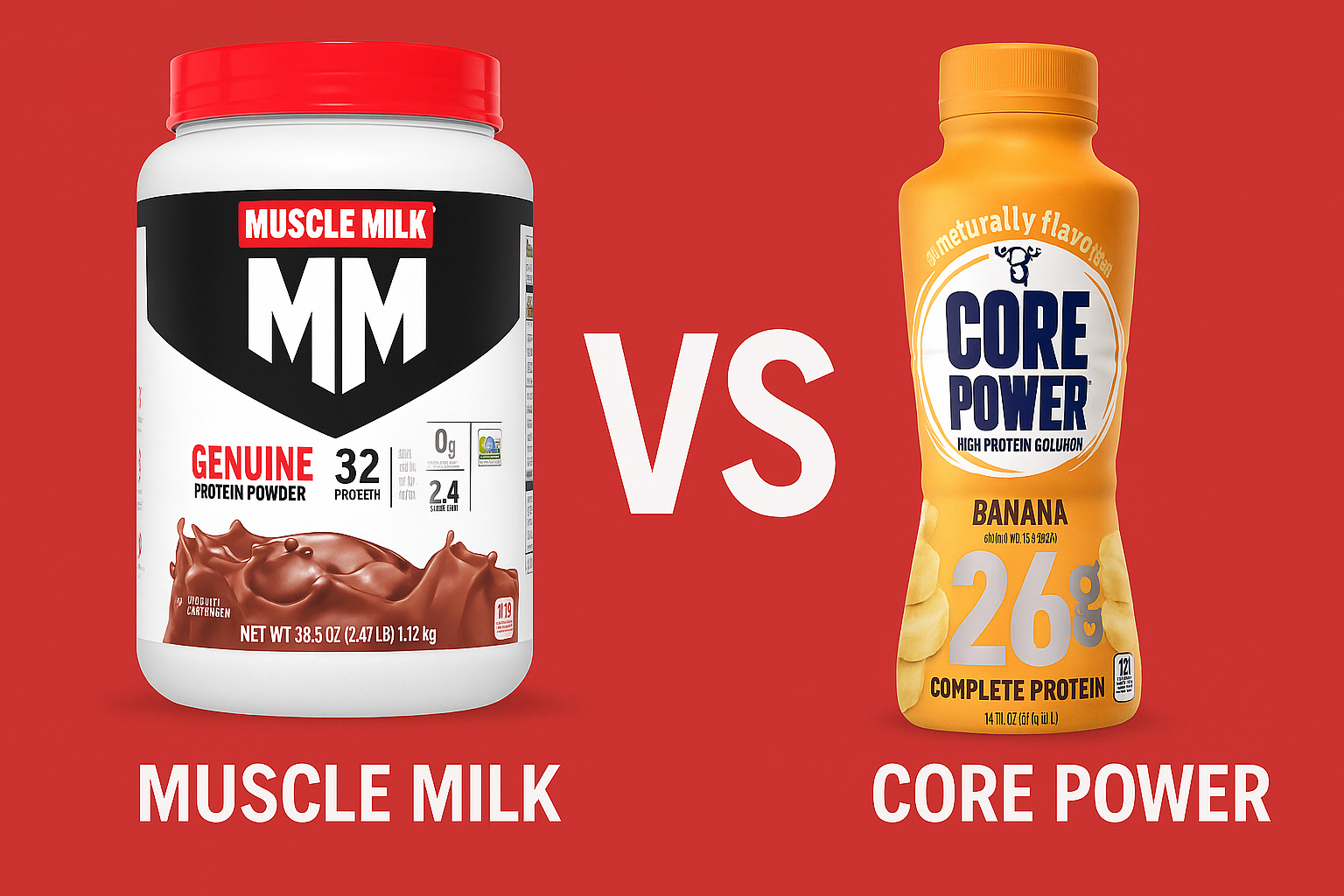Muscle Milk vs Core Power: Which Protein Shake Is Better?
When you’re looking for ready-to-drink protein shakes, two names frequently come up: Muscle Milk and Core Power. They target similar audiences — athletes, gym-goers, or anyone needing a protein boost on the go — but they differ in formulation, taste, nutrition, and branding.
This blog will help you understand:
- What each product is (brand, background)
- Their nutrition profiles and ingredient differences
- Pros, cons, and safety considerations
- Which might suit you better, given your goals
Let’s begin by introducing the two.
Brand Background & Positioning
Muscle Milk
- Manufacturer & Brand: Muscle Milk is produced by CytoSport, Inc., which is currently under the PepsiCo umbrella.
- Product Range: Muscle Milk is available both as ready-to-drink shakes and as powders. They market for “recovery, performance, muscle support.”
- Notable History & Issues: In the past, Muscle Milk faced scrutiny (e.g. a Consumer Reports investigation) about heavy metals (cadmium, lead, arsenic, mercury) in certain products. That doesn’t necessarily apply in all current formulas or regions, but it’s worth being aware of brand history when choosing protein supplements.
Core Power
- Manufacturer & Brand: Core Power is a product line from Fairlife. The “Core Power” brand is often associated with “ultra-filtered milk” formulations and premium protein shakes.
- Product Positioning: They promote Core Power as a “high protein milk shake” — more natural ingredient emphasis, milk-based, used after workouts or to “fight post-workout fatigue.”
- Nutrition Emphasis: Their marketing highlights build strength, recovery, and nutrition using real milk as the base rather than a heavy mix of powders.
Thus, while Muscle Milk often leans more “sports supplement” in image, Core Power leans more “dairy-based protein shake.”
Nutrition Comparison & Ingredient Breakdown
Below is a comparative view (approximate, based on typical variants) of Muscle Milk vs Core Power. Be sure to check the exact label in your region because formulations vary.
| Feature | Muscle Milk (typical ready-to-drink) | Core Power (typical / “Elite” variant) |
|---|---|---|
| Protein per serving | Often in the range of 20-32 g (depending on variant) | The “Elite” version offers 42 g protein per bottle in some markets. |
| Calories | E.g., Muscle Milk Genuine: ~160 kcal for ~25 g protein, zero sugar version | Example: Core Power Elite is ~230 calories per bottle. |
| Carbohydrates / Sugars | Some variants are zero sugar, or very low sugar. | In some markets, Core Power Elite has ~8 g sugar (may be from milk lactose) in a 3.5 g fat, 8 g carbs formula. |
| Fat | Varies by variant; some are low-fat or moderate fat. | The Core Power Elite has ~3.5 g fat in one formulation. |
| Calcium & Micronutrients | Muscle Milk often fortifies with vitamins & minerals; exact amounts depend on product. | Core Power typically highlights calcium, vitamin D, etc., as part of its marketing. |
| Protein Source / Type | A blend of proteins (often milk-derived, whey, casein) depending on variant. | Primarily ultra-filtered milk proteins (casein + whey) rather than added powders. |
| Sweeteners / Additives | Some products use artificial sweeteners, flavorings, stabilizers, etc. | Also uses flavorings, stabilizers; some variants might include artificial sweeteners or thickening agents. |
| Lactose / Digestibility | Some variants are lactose reduced or labeled lactose-free/low lactose; others may still contain dairy sugar. | Core Power is often marketed as lactose-free (or processed to reduce lactose). |
| Texture / Mouthfeel | Varies by variant — some are thick, some more drinkable. | Often marketed as smoother milkshake-style consistency. |
| Cost / Price | Depending on region and product variant, might be more premium in many markets. | Also positioned as premium; price may be high for high protein content. |
Other Ingredient & Safety Considerations
- Additives & Thickeners: Both brands may use stabilizers, emulsifiers, or thickening agents to maintain texture. For instance, Core Power may include “natural flavors” and thickening agents.
- Sweeteners: Artificial sweeteners (e.g., sucralose, acesulfame K) might be used in some flavored or low-sugar variants in both brands.
- Allergen / Lactose: Although Core Power often advertises itself as lactose-free, it is still a dairy-based product, and people with severe dairy allergies or intolerance should be cautious.
- Quality & Contamination Concerns: As mentioned earlier, Muscle Milk has had past investigations concerning heavy metal content in some formulations. It’s wise to check current third-party lab testing, certifications, and local regulatory compliance when available.
Pros & Cons: Which One Shines Where
Below is a breakdown of strengths & weaknesses for each brand or variant. Again, your experience may differ depending on variant and local version.
Pros of Muscle Milk
- Variety: Many variants—low sugar, zero sugar, “Pro” formulas—give flexibility.
- Lower sugar options: Some versions are zero sugar or low sugar.
- Established brand: Strong presence in sports nutrition market, wide availability in many markets.
- High vitamin & mineral fortification in many versions.
Cons / Potential Drawbacks of Muscle Milk
- Taste / aftertaste: Some users report strong artificial taste or lingering aftertaste.
- Past safety scrutiny: Some older formulations were flagged in independent testing for heavy metal content.
- In some versions, lower protein per serving compared to Core Power Elite (depending on variant).
- Use of additives / sweeteners may not appeal to more “natural” product seekers.
Pros of Core Power
- High protein density: The Elite version is marketed with a high dose (e.g. ~42 g) in a single bottle.
- Milk-based, “real milk” appeal: Its marketing emphasizes using ultra-filtered milk rather than heavy protein powder blends.
- Smooth, creamy texture: Many consumers appreciate its shake-like consistency.
- Lactose-friendly / easier digestibility (depending on variant)
- Strong micronutrient content (calcium, D, etc.)
Cons / Potential Drawbacks of Core Power
- Price: High protein and premium branding often come with premium pricing.
- Sugar / carbs: Some variants have non-negligible sugar or lactose content (or residual sugars).
- Use of additives: Though “milk-based,” additives like stabilizers, flavorings, etc., are still present.
- Overkill protein? For lighter users, the 42 g dose may be more than needed in one go (more on that below).
Which One Fits Which User?
Choosing between Muscle Milk and Core Power often depends on your goals, digestion tolerance, budget, and taste preference. Here are some scenarios:
- If you want maximum protein in one bottle: Core Power Elite may give you a high gram count in one drink, which is useful if you’re trying to hit high daily protein targets.
- If you’re sugar-conscious / want low sugar: Some Muscle Milk variants are tailored for zero or very low sugar, so those might edge slightly ahead depending on the flavor and variant.
- If you prefer a milkshake-like texture: Core Power tends to lean more toward creamy milkshake consistency, which many users prefer.
- If you have mild lactose intolerance: Core Power’s lactose processing / ultra-filtered milk claims may help (though not guaranteed). You’ll want to test your tolerance.
- If budget is a concern: Compare local prices. Sometimes the premium protein in Core Power may justify the cost; other times, a mid-tier Muscle Milk variant may give better value.
- If you care about purity / lower contaminants: Review third-party lab tests, independent reviews, or consumer reports in your region. Because Muscle Milk has had scrutiny in the past, you might prefer a brand with transparent testing or certifications.
Usage Tips & Best Practices
Here are tips to get the most benefit and safety from either product:
- Don’t rely solely on shakes: They are supplements or aides — you should still aim to get most of your protein and nutrients from whole foods (meat, eggs, legumes, dairy, etc.).
- Spread protein intake: If your daily protein goal is high (say 120–150 g), splitting into multiple servings (~25–35 g each) may help absorption and utilization.
- Pair with carbs/fats post-workout: A shake alone may be protein-heavy but light on carbs or fat. Combining with fruit, oats, nuts, etc., can help recovery better.
- Stay hydrated: High protein intake demands good hydration and healthy kidney function.
- Check local labeling: Always verify the exact ingredients, nutrition, and warnings on the label in your country, because formulations may differ.
- Watch for reactions: If you feel bloated, gassy, or have discomfort, reduce or test with half-portion.
My Take / Recommendation (Based on Comparative View)
If I were to pick, I’d lean toward Core Power (Elite variant) for my post-workout shake — mainly because of its higher protein density, milk-based formulation, and creamy texture. But that’s assuming the cost is acceptable and I tolerate it well.
However, I don’t think Muscle Milk is a bad choice — if you find a variant you like (taste, low sugar, suitable price) and it meets your protein needs, it remains a solid option.
The “best” between the two really comes down to personal fit — your digestive tolerance, protein target, flavor preferences, and budget.

